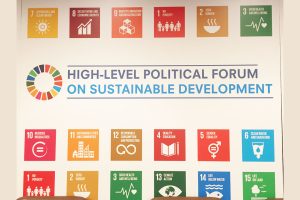By Abdur Rehman Cheema, an Islamabad-based economist and development practitioner. Cheema is the lead author of Pakistan’s first SDGs Status Report 2021. Views are his own. He can be reached at arehmancheema@gmail.com. His other similar works on water, climate change, and sustainability can be found here.
‘Pakistan SDGs Status Report 2021’ presents Pakistan’s progress on the SDGs using national and provincial data. The first of its kind, the status report, published by the Federal SDGs Support Unit at the Ministry of Planning Development and Special Initiatives, Pakistan, highlights the country’s progress on SDG indicators vis-à-vis their 2014-2015 baseline values. The report presents data on 133 SDG indicators with their corresponding latest values. Overall, the report assesses Pakistan’s progress on the SDGs as “modest.”
Pakistan’s progress on SDG 1 (no poverty) is steady. Poverty consistently declined in the period from 2014-2015 until 2018-2019, with 9.3 million people lifted out of poverty, based on the national poverty line. Similarly, Pakistan witnessed a significant decline in the proportion of the population affected by disasters. In a drive towards zero hunger (SDG 2), undernourishment declined by 4.2% from 20.2% in 2015 to 16% in 2019.
Pakistan shows modest progress in the basic health indicators of SDG 3 (good health and well-being). The number of mothers dying during pregnancy and in child birth reduced by 32.6% from 2007 to 2019. Births attended by skilled health personnel increased by 10% in the five years from 2013 to 2018. National vaccination coverage improved by 11.5% in the period from 2013-2018.
The country’s progress on achieving quality education (SDG 4), however, is dismal. The primary school completion rate stagnated at 67% in the five years from 2015-2020. The national literacy rate remained at 60% in the same period.
On gender equality (SDG 5), Pakistan shows progress on several fronts. The proportion of women in managerial positions (SDG indicator 5.5.2) nearly doubled between 2015 (2.7%) and 2019 (4.53%). Physical violence reduced by 5.3% from 18% in 2012-2013 to 13.6% in 2017-2018 nationwide. Khyber Pakhtunkhwa and Balochistan, which had previously recorded the highest rates of physical violence against women (31%), saw numbers decline from 2013-2018 to 23.4% and 34.6%, respectively.
Access to clean water and sanitation (SDG 6) also shows improvements at the national and provincial levels. Improved sources of drinking water are available to 94% of the country’s population. Access to improved drinking water in Balochistan increased by 17% from 2015-2020.
Pakistan’s commitment to the environment is evidenced by an increase in the share of renewable energy (SDG 7) by more than four times between 2015 and 2019. Reliance on clean fuel for cooking nationwide increased to 47% in the period from 2018-2019, from the floor of 41.3% in 2014-2015.
Progress on SDG 8 (decent work and economic growth) indicators is slow. The economy experienced a slowdown, with an annual growth rate of real GDP per capita declining to -3.36% in the fiscal year 2019-2020, from 2.04% in 2014-2015. Some progress was made on the SDG 9 (industry, innovation and infrastructure) targets. The proportion of small-scale industries in total industry value added increased to 10.5% in 2019-2020, from 8.4% in 2014-2015, despite the overall negative effects of COVID-19 in 2019-2020.
A slight dent was made in the reduction of income inequality – a 2% drop from 2016-2019, contributing to SDG 10 (reduced inequalities). A decline of 7% in the proportion of the urban population living in slums, informal settlements or inadequate housing (SDG 11 on sustainable cities and communities) also occurred, from 45% in 2014 to 38% in 2018.
Pakistan remains committed to addressing the problem of hazardous waste and achieving compliance with the Basel Convention as required under SDG 12 (responsible consumption and production). However, Pakistan’s contribution to SDG 13 (climate action) is minimal. The country has adopted and implemented national disaster risk reduction (DRR) strategies in line with the Sendai Framework on DRR, with the 2020 index score of 0.8, an improvement on 2018 when it was 0.4. However, greenhouse gas (GHG) emissions grew by 375.03 million tons in 2016, a 2.5% increase from 2015.
With respect to SDG 14 (life below water), Pakistan maintained the proportion of fish stocks within biologically sustainable levels at 30% between 2015 and 2020. Despite the growing population and rapid urbanization, Pakistan’s forest area as a proportion of total land – one of the targets of SDG 15 (life on land) – remained unchanged, at around 5% from 2015-2020.
Regarding SDG 16 (peace, justice and strong institutions), birth registration of children under five showed an improvement of 8.2% from 2013-2018. Pakistan is showing significant improvement on SDG 17 (partnerships for the Goals) on its journey towards digital transformation. Fixed internet broadband subscriptions per 100 inhabitants increased by 20% in the three years from 2017-2020.
Pakistan’s 2021 SDG status report visualizes the country’s progress through a nationally computed index by the SDGs Section and Federal SDGs Unit of the Ministry of Planning, Development and Special Initiatives. Pakistan’s SDG index was developed on the basis of national data sources collated from authentic and reliable sources.

